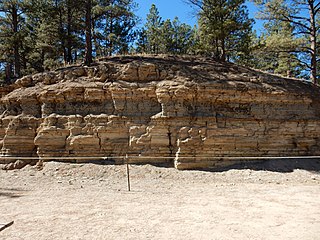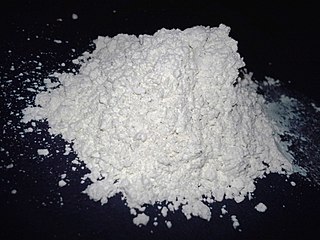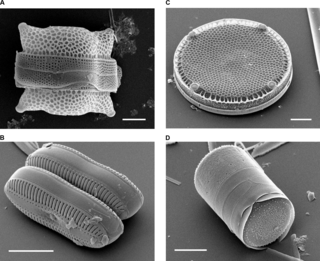
Diatomic molecules are molecules composed of only two atoms, of the same or different chemical elements. If a diatomic molecule consists of two atoms of the same element, such as hydrogen or oxygen, then it is said to be homonuclear. Otherwise, if a diatomic molecule consists of two different atoms, such as carbon monoxide or nitric oxide, the molecule is said to be heteronuclear. The bond in a homonuclear diatomic molecule is non-polar.

A diatom is any member of a large group comprising several genera of algae, specifically microalgae, found in the oceans, waterways and soils of the world. Living diatoms make up a significant portion of the Earth's biomass: they generate about 20 to 50 percent of the oxygen produced on the planet each year, take in over 6.7 billion tonnes of silicon each year from the waters in which they live, and constitute nearly half of the organic material found in the oceans. The shells of dead diatoms can reach as much as a half-mile deep on the ocean floor, and the entire Amazon basin is fertilized annually by 27 million tons of diatom shell dust transported by transatlantic winds from the African Sahara, much of it from the Bodélé Depression, which was once made up of a system of fresh-water lakes.

The Florissant Formation is a sedimentary geologic formation outcropping around Florissant, Teller County, Colorado. The formation is noted for the abundant and exceptionally preserved insect and plant fossils that are found in the mudstones and shales. Based on argon radiometric dating, the formation is Eocene in age and has been interpreted as a lake environment. The fossils have been preserved because of the interaction of the volcanic ash from the nearby Thirtynine Mile volcanic field with diatoms in the lake, causing a diatom bloom. As the diatoms fell to the bottom of the lake, any plants or animals that had recently died were preserved by the diatom falls. Fine layers of clays and muds interspersed with layers of ash form "paper shales" holding beautifully-preserved fossils. The Florissant Fossil Beds National Monument is a national monument established to preserve and study the geology and history of the area.
Fucoxanthin is a xanthophyll, with formula C42H58O6. It is found as an accessory pigment in the chloroplasts of brown algae and most other heterokonts, giving them a brown or olive-green color. Fucoxanthin absorbs light primarily in the blue-green to yellow-green part of the visible spectrum, peaking at around 510-525 nm by various estimates and absorbing significantly in the range of 450 to 540 nm.

Diatomaceous earth, diatomite, celite or kieselgur/kieselguhr is a naturally occurring, soft, siliceous sedimentary rock that can be crumbled into a fine white to off-white powder. It has a particle size ranging from more than 3 mm to less than 1 μm, but typically 10 to 200 μm. Depending on the granularity, this powder can have an abrasive feel, similar to pumice powder, and has a low density as a result of its high porosity. The typical chemical composition of oven-dried diatomaceous earth is 80–90% silica, with 2–4% alumina, and 0.5–2% iron oxide.

Ruth Myrtle Patrick was an American botanist and limnologist specializing in diatoms and freshwater ecology. She authored more than 200 scientific papers, developed ways to measure the health of freshwater ecosystems and established numerous research facilities.

Paleolimnology is a scientific sub-discipline closely related to both limnology and paleoecology. Paleolimnological studies focus on reconstructing the past environments of inland waters using the geologic record, especially with regard to events such as climatic change, eutrophication, acidification, and internal ontogenic processes.
Germanium dioxide, also called germanium(IV) oxide, germania, and salt of germanium, is an inorganic compound with the chemical formula GeO2. It is the main commercial source of germanium. It also forms as a passivation layer on pure germanium in contact with atmospheric oxygen.

Navicula is a genus of boat-shaped diatom algae, comprising over 1,200 species. Navicula is Latin for "small ship", and also a term in English for a boat-shaped incense-holder.

Diatomic carbon (systematically named dicarbon and 1λ2,2λ2-ethene), is a green, gaseous inorganic chemical with the chemical formula C=C (also written [C2] or C2). It is kinetically unstable at ambient temperature and pressure, being removed through autopolymerisation. It occurs in carbon vapor, for example in electric arcs; in comets, stellar atmospheres, and the interstellar medium; and in blue hydrocarbon flames. Diatomic carbon is the second simplest of the allotropes of carbon (after atomic carbon), and is an intermediate participator in the genesis of fullerenes.

The order Pennales is a traditional subdivision of the heterokont algae known as diatoms. The order is named for the shape of the cell walls of pennate diatoms, which are elongated in valve view. The valves may be linear or oval in shape, and usually bear bilaterally symmetrical ornamental patterns. These patterns are composed of a series of transverse lines that can appear as rows of dots when viewed with an optical microscope. Some pennate diatoms also exhibit a fissure along their longitudinal axis. This is known as a raphe, and is involved in gliding movements made by diatom cells; motile diatoms always possess a raphe.

The Coscinodiscophyceae are a class(s) of diatoms. They are similar to the Centrales, a traditional, paraphyletic subdivision of the heterokont algae known as diatoms. The order is named for the shape of the cell walls of centric diatoms, which are circular or ellipsoid in valve view. The valves often bear radially symmetrical ornamental patterns that can appear as dots when viewed with an optical microscope. Some also bear spines on their valves, which may either increase cell surface area and reduce sinking, or act as a deterrent to zooplankton grazers. Unlike pennate diatoms, centric diatoms never have a raphe.
In certain species of diatoms, auxospores are specialised cells that are produced at key stages in their cell cycle or life history. Auxospores typically play a role in growth processes, sexual reproduction or dormancy.

Thalassiosira pseudonana is a species of marine centric diatoms. It was chosen as the first eukaryotic marine phytoplankton for whole genome sequencing. T. pseudonana was selected for this study because it is a model for diatom physiology studies, belongs to a genus widely distributed throughout the world's oceans, and has a relatively small genome at 34 mega base pairs. Scientists are researching on diatom light absorption, using the marine diatom of Thalassiosira. The diatom requires a high enough concentration of CO2 in order to utilize C4 metabolism (Clement et al. 2015).

A frustule is the hard and porous cell wall or external layer of diatoms. The frustule is composed almost purely of silica, made from silicic acid, and is coated with a layer of organic substance, which was referred to in the early literature on diatoms as pectin, a fiber most commonly found in cell walls of plants. This layer is actually composed of several types of polysaccharides.

Siliceous ooze is a type of biogenic pelagic sediment located on the deep ocean floor. Siliceous oozes are the least common of the deep sea sediments, and make up approximately 15% of the ocean floor. Oozes are defined as sediments which contain at least 30% skeletal remains of pelagic microorganisms. Siliceous oozes are largely composed of the silica based skeletons of microscopic marine organisms such as diatoms and radiolarians. Other components of siliceous oozes near continental margins may include terrestrially derived silica particles and sponge spicules. Siliceous oozes are composed of skeletons made from opal silica SiO2·nH2O, as opposed to calcareous oozes, which are made from skeletons of calcium carbonate (CaCO3·nH2O) organisms (i.e. coccolithophores). Silica (Si) is a bioessential element and is efficiently recycled in the marine environment through the silica cycle. Distance from land masses, water depth and ocean fertility are all factors that affect the opal silica content in seawater and the presence of siliceous oozes.
Miracula is a genus of parasitic protists that parasite diatoms, containing the type species Miracula helgolandica. More recently, the species Miracula moenusica from the river Main in Frankfurt am Main, Miracula islandica from a shore in the north of Iceland, Miracula einbuarlaekurica from a stremlet in the north of Iceland, and Miracula blauvikensis from the shore at the research station Blávík in the east fjords of Iceland were added to the genus. It is the only genus in the family Miraculaceae, of uncertain taxonomic position within the Oomycetes. They're one of the most basal lineages in the phylogeny of Oomycetes.

Forensic limnology is a sub-field of freshwater ecology, which focuses especially on the presence of diatoms in crime scene samples and victims. Different methods are used to collect this data but all identify the ratios of different diatom colonies present in samples and match those samples with locations at the crime scene.
Cymatosiraceae is a family of diatoms in the order Cymatosirales.

Diatoms belong to a large group called the heterokonts, which include both autotrophs such as golden algae and kelp; and heterotrophs such as water moulds. The classification of heterokonts is still unsettled: they may be designated a division, phylum, kingdom, or something intermediate to those. Consequently, diatoms are ranked anywhere from a class, usually called Diatomophyceae or Bacillariophyceae, to a division (=phylum), usually called Bacillariophyta, with corresponding changes in the ranks of their subgroups.













